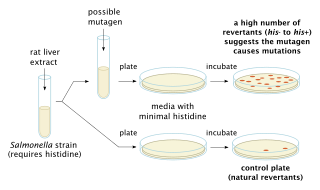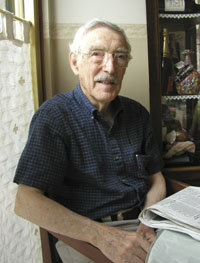Related Research Articles

The Ames test is a widely employed method that uses bacteria to test whether a given chemical can cause mutations in the DNA of the test organism. More formally, it is a biological assay to assess the mutagenic potential of chemical compounds. A positive test indicates that the chemical is mutagenic and therefore may act as a carcinogen, because cancer is often linked to mutation. The test serves as a quick and convenient assay to estimate the carcinogenic potential of a compound because standard carcinogen assays on mice and rats are time-consuming and expensive. However, false-positives and false-negatives are known.
Mutagenesis is a process by which the genetic information of an organism is changed by the production of a mutation. It may occur spontaneously in nature, or as a result of exposure to mutagens. It can also be achieved experimentally using laboratory procedures. A mutagen is a mutation-causing agent, be it chemical or physical, which results in an increased rate of mutations in an organism's genetic code. In nature mutagenesis can lead to cancer and various heritable diseases, and it is also a driving force of evolution. Mutagenesis as a science was developed based on work done by Hermann Muller, Charlotte Auerbach and J. M. Robson in the first half of the 20th century.

In genetics, a mutagen is a physical or chemical agent that permanently changes genetic material, usually DNA, in an organism and thus increases the frequency of mutations above the natural background level. As many mutations can cause cancer in animals, such mutagens can therefore be carcinogens, although not all necessarily are. All mutagens have characteristic mutational signatures with some chemicals becoming mutagenic through cellular processes.
Genotoxicity is the property of chemical agents that damage the genetic information within a cell causing mutations, which may lead to cancer. While genotoxicity is often confused with mutagenicity, all mutagens are genotoxic, but some genotoxic substances are not mutagenic. The alteration can have direct or indirect effects on the DNA: the induction of mutations, mistimed event activation, and direct DNA damage leading to mutations. The permanent, heritable changes can affect either somatic cells of the organism or germ cells to be passed on to future generations. Cells prevent expression of the genotoxic mutation by either DNA repair or apoptosis; however, the damage may not always be fixed leading to mutagenesis.

Bruce Nathan Ames is a prominent American biochemist. He is a professor of biochemistry and Molecular Biology Emeritus at the University of California, Berkeley, and was a senior scientist at Children's Hospital Oakland Research Institute (CHORI). Throughout his career, Dr. Ames has made significant contributions to understanding the mechanisms of mutagenesis and DNA repair. One of his most notable achievements is the invention of the Ames test, a widely used assay for easily and cheaply evaluating the mutagenicity of compounds. The test revolutionized the field of toxicology and has played a crucial role in identifying numerous environmental and industrial carcinogens.
In molecular biology, an amplicon is a piece of DNA or RNA that is the source and/or product of amplification or replication events. It can be formed artificially, using various methods including polymerase chain reactions (PCR) or ligase chain reactions (LCR), or naturally through gene duplication. In this context, amplification refers to the production of one or more copies of a genetic fragment or target sequence, specifically the amplicon. As it refers to the product of an amplification reaction, amplicon is used interchangeably with common laboratory terms, such as "PCR product."

Sudan I is an organic compound, typically classified as an azo dye. It is an intensely orange-red solid that is added to colourise waxes, oils, petrol, solvents, and polishes. Sudan I has also been adopted for colouring various foodstuffs, especially curry powder and chili powder, although the use of Sudan I in foods is now banned in many countries, because Sudan I, Sudan III, and Sudan IV have been classified as category 3 carcinogens by the International Agency for Research on Cancer. Sudan I is still used in some orange-coloured smoke formulations and as a colouring for cotton refuse used in chemistry experiments.
Protein methods are the techniques used to study proteins. There are experimental methods for studying proteins. Computational methods typically use computer programs to analyze proteins. However, many experimental methods require computational analysis of the raw data.

A micronucleus is a small nucleus that forms whenever a chromosome or a fragment of a chromosome is not incorporated into one of the daughter nuclei during cell division. It usually is a sign of genotoxic events and chromosomal instability. Micronuclei are commonly seen in cancerous cells and may indicate genomic damage events that can increase the risk of developmental or degenerative diseases.

The single cell gel electrophoresis assay is an uncomplicated and sensitive technique for the detection of DNA damage at the level of the individual eukaryotic cell. It was first developed by Östling & Johansson in 1984 and later modified by Singh et al. in 1988. It has since increased in popularity as a standard technique for evaluation of DNA damage/repair, biomonitoring and genotoxicity testing. It involves the encapsulation of cells in a low-melting-point agarose suspension, lysis of the cells in neutral or alkaline (pH>13) conditions, and electrophoresis of the suspended lysed cells. The term "comet" refers to the pattern of DNA migration through the electrophoresis gel, which often resembles a comet.

A clastogen is a mutagenic agent that disturbs normal DNA related processes or directly causes DNA strand breakages, thus causing the deletion, insertion, or rearrangement of entire chromosome sections. These processes are a form of mutagenesis which if left unrepaired, or improperly repaired, can lead to cancer. Known clastogens include acridine yellow, benzene, ethylene oxide, arsenic, phosphine, mimosine, actinomycin D, camptothecin, methotrexate, methyl acrylate, resorcinol and 5-fluorodeoxyuridine. Additionally, 1,2-dimethylhydrazine is a known colon carcinogen and shows signs of possessing clastogenic activity. There are many clastogens not listed here and research is ongoing to discover new clastogens. Some known clastogens only exhibit clastogenic activity in certain cell types, such as caffeine which exhibits clastogenic activity in plant cells. Researchers are interested in clastogens for researching cancer, as well as for other human health concerns such as the inheritability of clastogen effected paternal germ cells that lead to fetus developmental defects.

In molecular genetics, a DNA adduct is a segment of DNA bound to a cancer-causing chemical. This process could lead to the development of cancerous cells, or carcinogenesis. DNA adducts in scientific experiments are used as biomarkers of exposure. They are especially useful in quantifying an organism's exposure to a carcinogen. The presence of such an adduct indicates prior exposure to a potential carcinogen, but it does not necessarily indicate the presence of cancer in the subject animal.

IIT Research Institute (IITRI), also known historically and interchangeably as IIT Research Center, is a high-technology scientific research organization and applied research laboratory located in Chicago, Illinois. Previously known as the Armour Research Foundation, the IITRI is an independent corporation that operates collaboratively with the Illinois Institute of Technology (IIT) and the U.S. Government.
Minimal residual disease (MRD), also known as Molecular residual disease, is the name given to small numbers of cancer cells that remain in a person either during or after treatment when the patient is in remission. Sensitive molecular tests are either in development or available to test for MRD. These can measure minute levels of cancer cells in tissue samples, sometimes as low as one cancer cell in a million normal cells, either using DNA, RNA or proteins.
Mutation Research is a peer-reviewed scientific journal that publishes research papers in the area of mutation research which focus on fundamental mechanisms underlying the phenotypic and genotypic expression of genetic damage. There are currently three sections:
The Environmental Mutagenesis and Genomics Society (EMGS) is a scientific society "for the promotion of critical scientific knowledge and research into the causes and consequences of damage to the genome and epigenome in order to inform and support national and international efforts to ensure a healthy, sustainable environment for future generations."
Gareth Jenkins is a professor of molecular carcinogenesis at Swansea University Medical School. Based in the Institute of Life Science, his interests include the study of DNA mutation induction and the role of DNA mutations as diagnostic biomarkers for cancer. He is also director of research of the medical school and a “research leader” for Health and Care Research Wales. Jenkins' research gained much recognition during 2016 when his revolutionary cancer-detecting blood test was widely covered in the British press.

Cyclotriol is a synthetic estrogen which was studied in the 1990s and was never marketed. It is a derivative of estriol with a bridge between the C14α and C17α positions. The drug has 40% of the relative binding affinity of estradiol for the human ERα. It showed an absolute bioavailability of 40% with high interindividual variability and an elimination half-life of 12.3 hours in pharmacokinetic studies in women.

Lynnette Robin Ferguson is a New Zealand academic, and as of 2021 is an emeritus professor at the University of Auckland. Ferguson has been a Fellow of the Royal Society Te Apārangi since 2016.
The somatic mutation and recombination tests (SMARTs) are in vivo genotoxicity tests performed in Drosophila melanogaster (Fruit fly). These fruit fly tests are a short-term test and a non-mammalian approach for in vivo testing of putative genotoxins found in the environment. D. melanogaster has a short lifespan, which allows for fast reproductive cycles and high-throughput genotoxicity testing. D. melanogaster also has around 75% functional orthologs of human disease-related genes, making it an attractive in vivo model for human research. The tests identify loss of heterozygosity for the specified genetic markers in heterozygous or trans-heterozygous adults using phenotypically observable genetic markers in adult tissues. Although diverse events like point mutations/deletions, nondisjunction, and homologous mitotic recombination might theoretically cause this loss of heterozygosity, nondisjunction processes are generally not relevant for most of the examined chemicals. SMARTs are two different tests that use the same genetic foundation, but target different adult tissues and are named accordingly: the wing-spot test and the eye-spot test.
References
- ↑ Anderson, Diana; University of Manchester (1973). Drug resistant variants in mammalian cells in vitro. Manchester: University of Manchester. OCLC 643536097.
- 1 2 3 4 5 6 "Test for early cancer detection - Research blog". University of Bradford. Retrieved 2022-01-02.
- ↑ "Potential 'universal' blood test for cancer discovered". EurekAlert!. Retrieved 2022-01-02.
- ↑ "Women who invent: Hedy Lamarr and Diana Anderson". National Science and Media Museum blog. Retrieved 2022-01-02.
- ↑ "Bradford scientist Diana Anderson receives MBE". University of Bradford. Retrieved 2022-01-02.
- ↑ "No. 63571". The London Gazette (Supplement). 1 January 2022. p. N16.
- 1 2 "ASTEC Susan Smith - Emeritus Director". www.astec.stfc.ac.uk. Retrieved 2022-01-02.
- ↑ "Academics aiming to show their enterprise". www.yorkshirepost.co.uk. Retrieved 2022-01-02.
- ↑ "University Vice-Chancellor recognises outstanding achievement". University of Bradford. Retrieved 2022-01-02.
- ↑ "University professor shortlisted for outstanding women award". Bradford Telegraph and Argus. Retrieved 2022-01-02.